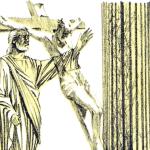At one church in our archdiocese, the Sign of Peace is offered enthusiastically. Clandestine handshakes give way to effluous hugs, cheeky kisses, whispered greetings. Worshippers reach out, grasping one another’s hands during the Our Father. United in joy and praise, they raise their clasped hands high as they say, “For the kingdom, the power and the glory are yours, now and forever.” These faithful Catholics welcome the opportunity to celebrate their unity and enjoy the casual friendships that are expressed in the simple act of joining with their fellow believers during the liturgy.
At another church just a few miles away, people are scornful of this expression of unity, preferring to retain focus on the altar and the liturgy without turning away, even for a minute, to greet their pewmates.
* * * * *
Unfortunately, individual preferences and practices like this have the potential of driving conservative and liberal Catholics further and further apart, when in reality…
- Both goals—friendly acceptance, and serene reverence—are noble.
- Both criticisms—that the person who refuses to shake your hand is a rigid old grump, and that a casual greeting distracts and detracts from worship—are legitimate concerns.
* * * * *
The Congregation for Divine Worship has, for the past eleven years, been reconsidering the issue—evaluating concerns, discussing a proposal to move the Sign of Peace to another point in the liturgy, perhaps preceding the presentation of the gifts, rather than potentially disrupting the Mass just as people are preparing to receive communion.
* * * * *
This week a decision was communicated, and no–the Sign of Peace will not be eliminated or moved. The Congregation did, however, make some recommendations which may help to reduce the potential distractions at that holy moment of the Mass.
On July 28, Fr. Jose Maria Gil Tamayo, secretary general of the Spanish bishops’ conference, released a memo explaining that the Sign of Peace will be retained in its current position in the Mass—after the Consecration, and before the faithful process forward to receive Communion. However, Fr. Gil emphasized in his communication, priests should make a concerted effort to retain the dignity of the moment, and to avoid any excessive distraction.
The Tablet offers a good synopsis of the recommendations for a “more sober, less worldly” greeting:
The Vatican has called for the faithful to be more restrained when offering the sign of peace during Mass.
The Congregation for Divine Worship (CDW) has instructed bishops to draw up new guidelines so that the gesture can be performed with more sobriety and less “excess”. It advised bishops to find alternatives to the use of “familiar” or “worldly” greetings.
The CDW said it would “offer some practical measures to better express the meaning of the sign of peace and to moderate excesses, which create confusion in the liturgical assembly just prior to Communion”.
It said priests should avoid leaving the altar to offer parishioners the sign of peace, and criticised those who moved from their place or offered congratulations or condolences during the sign of the peace at nuptial or requiem Masses.
“If the faithful do not understand and do not show, in their ritual gestures, the true significance of the rite of peace, they are weakened in the Christian concept of peace, and their fruitful participation in the Eucharist is negatively affected.”
Specifically, the Congregation for Divine Worship and Discipline of the Sacraments listed four recommendations for change. Catholic News Agency summarizes:
-
First, while confirming the importance of the rite, it emphasized that “it is completely legitimate to affirm that it is not necessary to invite ‘mechanistically’ to exchange (the sign of) peace.” The rite is optional, the congregation reminded, and there certainly are times and places where it is not fitting.
-
Its second recommendation was that as translations are made of the third typical edition of the Roman Missal, bishops’ conference should consider “changing the way in which the exchange of peace is made.” It suggested in particular that “familiar and worldly gestures of greeting” should be substituted with “other, more appropriate gestures.”
-
The congregation for worship also noted that there are several abuses of the rite which are to be stopped: the introduction of a “song of peace,” which does not exist in the Roman rite; the faithful moving from their place to exchange the sign; the priest leaving the altar to exchange the sign with the faithful; and when, at occasions such as weddings or funerals, it becomes an occasion for congratulations or condolences.
-
The Congregation for Divine Worship’s final exhortation was that episcopal conferences prepare liturgical catechesis on the significance of the rite of peace, and its correct observation.
It’ll be interesting to see how the CDW’s suggestions–especially #2 and #4–will be implemented here in the United States. Presumably, the U.S. Conference of Catholic Bishops will address this at their Fall General Assembly in Baltimore this November.













